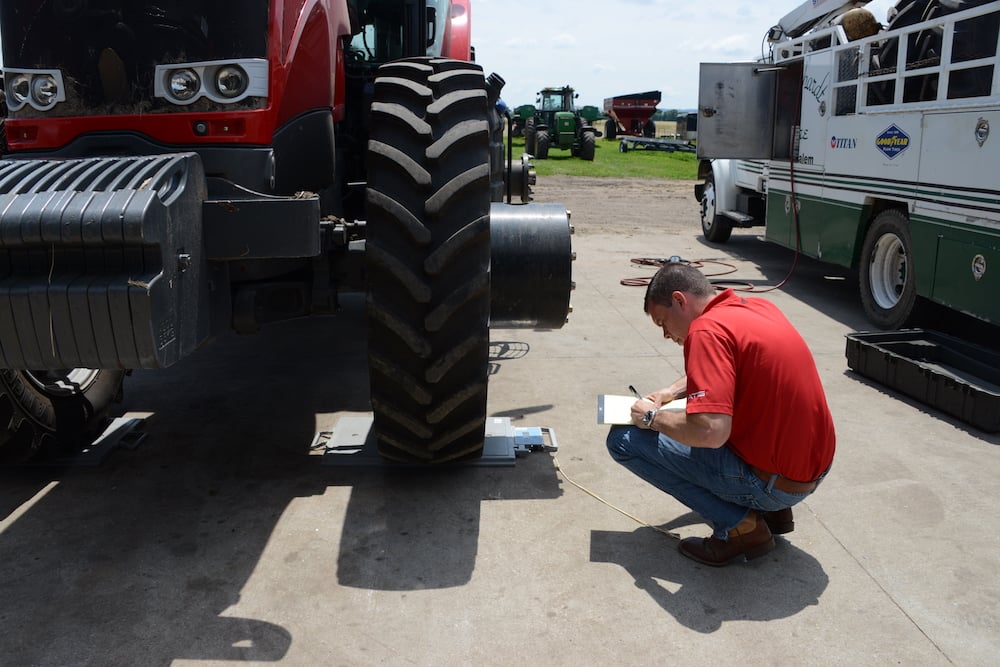Improve Farm Profits for Free
Did you know there’s an easy and free way to save fuel, increase flotation, improve traction, and reduce soil compaction? It’s true! And all you need to do to reap these benefits is simply check the inflation pressure of your farm equipment’s tires on a regular basis to ensure they’re operating at the manufacturers’ recommended guidelines. That's all it takes!

Why Pressure Matters
A common misconception held by farmers is that tires bear the weight of a tractor. Actually, tires are simply vessels for air—the air does the real work of the tire and explains why flat tires are known for causing downtime, not load-carrying capacity. Because of this, air pressure has an enormous effect on the performance of a machine. For example, tractors running on improperly inflated tires can waste between 20% and 40% of engine power through tire slippage and rolling resistance, meaning a 400-horsepower tractor might only be putting 240 horsepower on the ground.
Weigh Your Machine
In order to properly inflate a tractor’s tires, it’s imperative to know the machine’s weight—including the weight of its load—at each axle, along with the knowledge of the speed at which it will be traveling. A grain or truck scale is a handy tool for finding out the weight of a tractor.
Ballast and Balance
In order to transfer horsepower to the ground efficiently, tractors need to apply a certain amount of weight to the ground. A good rule of thumb is that MFWD tractors need between 130 and 140 pounds of total weight per engine horsepower while 4WD tractors require between 95 and 110 pounds per horsepower. Equally important to ensuring a tractor is operating at the correct weight is making sure the weight is distributed properly. A general guideline is that the weight should be split with 35% on the front and 65% on the rear for MFWD tractors and 55% on the front and 45% on the rear on 4WD tractors. Rather than rely on generalizations, we suggest checking with your equipment dealer to get the correct figures before configuring your machine.
Consult the Tire Manufacturer’s Speed and Load Charts
With your tractor properly ballasted, it’s time to consult the tire manufacturer's speed and load charts for their inflation pressure recommendations. We know the importance of operating tires at their ideal inflation pressure and work to make our speed and load tables easily accessible—our speed and load tables can be found on our website and, because tires aren’t often inflated in front of a computer, through our mobile tire app, which is available for both Apple and Android operating systems. Calculate using the maximum speed and load you expect your machinery to experience.
Get a Good Gauge
Due to the vital role air pressure plays in the performance of a tire, we suggest checking the air pressure of a tractor’s tires frequently—a minimum of once a week. A reliable tire pressure gauge is necessary for this and we suggest getting a new tire gauge every year, as they wear out and become less accurate over time and use. It’s preferable to check the tire pressure in the morning when cold for two reasons: 1) tire manufacturers’ speed and load tables are built assuming a tire is cold, and 2) the air inside a tire heats up and expands when in use, which can result in higher pressure.
The Perils of Tire Under-inflation
As mentioned earlier, properly inflated tractor tires can increase a machine’s productivity and efficiency, reduce its operating costs (fuel and tires), increase flotation and reduce soil compaction, and increase profits in the long run. However, failure to correctly inflate tires can lead to a host of issues. For example, over-inflated tires can lead to reduced tire life, increase compaction, add unnecessary wear to the tractor, and reduce operator comfort. Likewise, an under-inflated tractor tire doesn’t contact the ground the way engineers designed it to, resulting in uneven wear, and loss of traction.
Contact your local dealer or rep today to learn how our Alliance AgriFlex IF/VF tires paired with proper inflation are providing farmers with the ultimate low-pressure solution to minimizing soil compaction.


